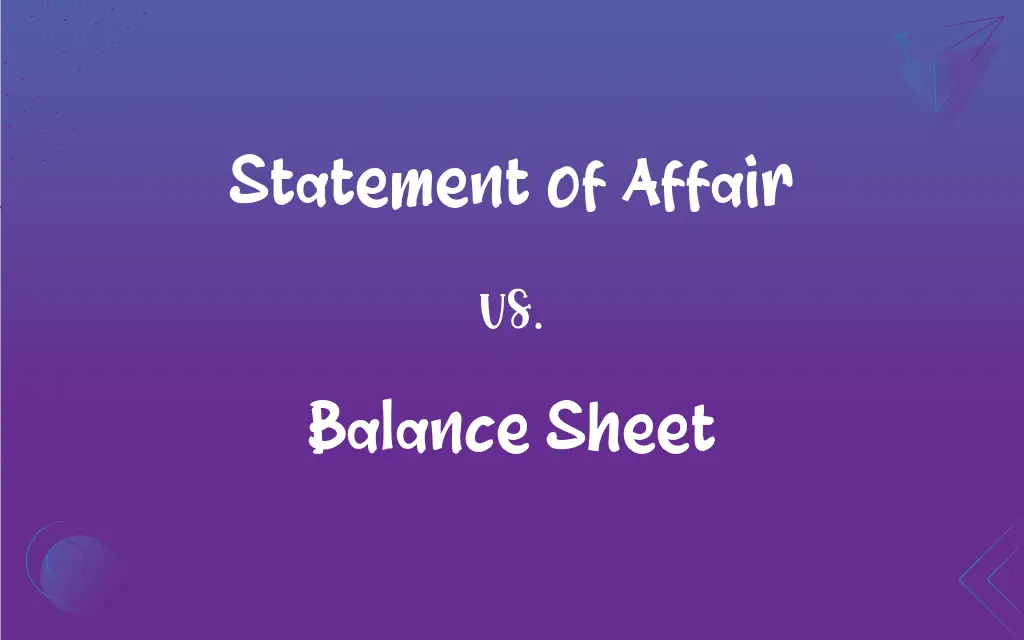Statement of Affair vs. Balance Sheet: What's the Difference?
By Janet White || Published on February 10, 2024
A statement of affairs is an insolvency document detailing a company's assets and liabilities, while a balance sheet is a financial statement showing a company's assets, liabilities, and equity at a specific time.

Key Differences
A statement of affairs is a document usually prepared in the context of insolvency, providing a snapshot of the company's financial status by listing its assets and liabilities. In contrast, a balance sheet is a fundamental financial statement used by companies in regular financial reporting, reflecting the company's financial position, including assets, liabilities, and shareholders' equity, at a specific point in time.
The statement of affairs is often used to assess the company's financial position in a distress situation, such as bankruptcy, where it is crucial for understanding the potential for paying off debts. The balance sheet, meanwhile, is an essential part of a company's financial statements, used for a wide range of financial analysis, including solvency and liquidity assessment in normal business operations.
In preparing a statement of affairs, estimations and realizable values of assets are often emphasized, as it focuses on what can be achieved in an insolvency scenario. The balance sheet, however, records the historical cost of assets and liabilities, following accounting principles like conservatism and accruals, to present an accurate and fair view of the company’s financial status.
The audience for a statement of affairs typically includes creditors and insolvency practitioners, who use it to determine the likelihood and extent of recovery from a distressed company. The balance sheet is intended for a broader audience, including investors, regulators, and analysts, providing crucial information for decision-making and regulatory compliance.
The statement of affairs is not a regular feature in financial reporting and is specifically prepared for insolvency proceedings. In contrast, the balance sheet is a standard and mandatory component of a company’s annual and quarterly financial statements, providing ongoing insight into the company's financial health.
ADVERTISEMENT
Comparison Chart
Purpose
Prepared in insolvency situations
Regular financial reporting
Focus
Realizable value of assets and liabilities
Historical cost of assets, liabilities, and equity
Audience
Creditors, insolvency practitioners
Investors, regulators, analysts
Frequency
Prepared as needed in distress situations
Prepared regularly (annually, quarterly)
Emphasis
Estimation and potential liquidation value
Accurate and fair view of financial status
ADVERTISEMENT
Statement of Affair and Balance Sheet Definitions
Statement of Affair
A detailed report of a company's assets and liabilities, especially in insolvency.
The company's statement of affairs showed insufficient assets to cover its debts.
Balance Sheet
A report that provides a snapshot of a company's financial health at year-end.
The year-end balance sheet showed significant growth in the company's assets.
Statement of Affair
A document used to determine the solvency status of a company.
The court requested a statement of affairs to decide on the company's bankruptcy petition.
Balance Sheet
A tool for analyzing a company's financial leverage and liquidity.
The balance sheet revealed a high debt-to-equity ratio, indicating financial risk.
Statement of Affair
A financial statement prepared for assessing a company's ability to pay off debts.
The statement of affairs revealed more liabilities than assets, signaling financial distress.
Balance Sheet
A document reflecting the financial position of a business at a specific time.
The quarterly balance sheet showed an increase in liabilities due to new loans.
Statement of Affair
An insolvency document outlining the estimated realizable values of a company's assets.
The liquidator analyzed the statement of affairs to estimate asset recoveries.
Balance Sheet
A financial statement showing a company's assets, liabilities, and equity at a certain date.
The balance sheet indicated a strong equity position, boosting investor confidence.
Statement of Affair
A report used in bankruptcy to list all financial obligations and resources.
The statement of affairs was essential for creditors to understand their potential recovery.
Balance Sheet
A mandatory financial statement in corporate financial reporting.
The annual report's balance sheet helped investors assess the company's net worth.
FAQs
What is a balance sheet?
A financial statement showing a company's assets, liabilities, and equity at a specific time.
When is a statement of affairs used?
During insolvency proceedings or financial distress situations.
What is a statement of affairs?
It's a document detailing a company's assets and liabilities, typically used in insolvency.
What accounting principles does a balance sheet follow?
Generally Accepted Accounting Principles (GAAP) or International Financial Reporting Standards (IFRS).
How does a balance sheet help investors?
It provides insight into a company's financial health and stability.
How often is a balance sheet prepared?
Regularly, as part of annual and quarterly financial reporting.
Who uses the statement of affairs?
Creditors, insolvency practitioners, and courts in bankruptcy cases.
Does a statement of affairs show realizable asset values?
Yes, it focuses on the estimated realizable value of assets.
Is a statement of affairs mandatory in financial reporting?
No, it's prepared specifically for insolvency situations.
Can a statement of affairs be used for regular business analysis?
No, it's primarily used in distress or insolvency scenarios.
Who is the balance sheet intended for?
Investors, analysts, regulators, and company management.
What type of liabilities are listed in a statement of affairs?
All liabilities, focusing on amounts likely to be settled in insolvency.
Can these documents reflect a company's future prospects?
No, they are snapshots of financial status at a specific point in time.
Is equity part of a statement of affairs?
No, it mainly lists assets and liabilities, not equity.
Does a balance sheet include contingent liabilities?
Yes, but typically in the notes, not the main financial statements.
Are assets valued differently in these documents?
Yes, statement of affairs may use estimated liquidation values, while balance sheets use historical costs.
Is the balance sheet a required financial statement?
Yes, it's a mandatory part of standard financial reporting.
What is the main difference between the two documents?
The statement of affairs is for insolvency, balance sheet for regular financial reporting.
Are these documents audited?
Balance sheets are audited, but statements of affairs may not be, depending on the insolvency process.
What is the role of equity in a balance sheet?
It represents the residual interest in assets after deducting liabilities.
About Author
Written by
Janet WhiteJanet White has been an esteemed writer and blogger for Difference Wiki. Holding a Master's degree in Science and Medical Journalism from the prestigious Boston University, she has consistently demonstrated her expertise and passion for her field. When she's not immersed in her work, Janet relishes her time exercising, delving into a good book, and cherishing moments with friends and family.







































































